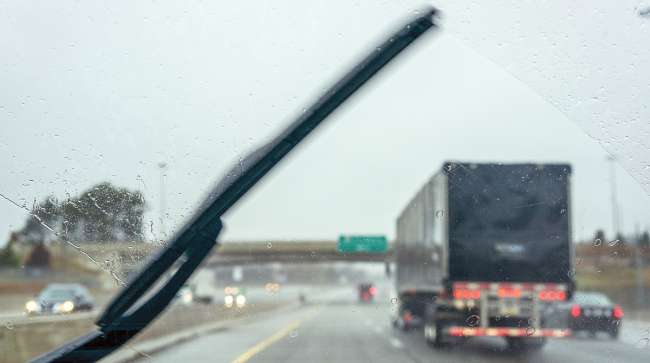Senior Reporter
FMCSA Plans to Increase Windshield Area to Mount Safety Devices

[Stay on top of transportation news: Get TTNews in your inbox.]
The Federal Motor Carrier Safety Administration has issued a proposal to amend its regulations to increase the allowable area vehicle safety technology devices may be mounted on the interior of commercial motor vehicle windshields.
If finalized, the proposal also would make permanent a number of temporary exemptions granted to motor carriers, truck makers and technology companies as far back as 2017. And it would add items to the definition of vehicle safety technology in response to a 2019 rulemaking petition from Daimler Trucks North America.
“This Notice of Proposed Rulemaking would provide a greater available area for the voluntary deployment of windshield-mounted safety technologies such as lane departure warning systems and automated emergency braking safety systems which have the potential to reduce fatalities, injuries and property damages while maintaining a level of safety equivalent to, or greater than, the level that would be achieved by the current regulation,” said the proposal, posted in the Federal Register earlier this month.
The agency said it would accept public comments on the proposal through Aug. 5.
Windshield Proposal by Transport Topics on Scribd
FMCSA said the expanded location — not more than 8.5 inches (216 mm) below the upper edge of the area swept by the windshield wipers, and not more than 7 inches (175 mm) above the lower edge of the area swept — is expected to keep pace with technological advances and further aid in meeting the statutory requirements.
The agency said it believes that the changes will be welcomed by motor carriers and drivers alike and that “coercion” to violate the revised provisions will not be an issue.
“The expanded area is outside the driver’s line of sight to the road, highway signs and signals,” the agency said.
Under the existing regulatory definitions, vehicle safety technology includes a fleet-related incident management system, performance or behavior management system, speed management system, lane departure warning system, forward collision warning or mitigation system, active cruise control system and transponder.
However, under the proposal, regulatory definitions would be added to also include braking warning systems, braking assist systems, automatic emergency braking, driver camera systems, attention assist warning, global positioning systems and traffic sign recognition. Vehicle safety technology includes systems and devices that contain cameras, lidar, radar, sensors and/or video, FMCSA said.
Regulators said the proposal would hopefully help remove barriers to the development and deployment of artificial intelligence.
“The deployment of AI holds the promise to improve efficiency, effectiveness, safety, fairness, welfare, transparency, and other economic and social goals, and America’s continued status as a global leader in AI development is important to preserving our economic and national security,” FMCSA said. “The importance of developing and deploying AI requires a regulatory approach that fosters innovation and growth and engenders trust, while protecting core American values, through both regulatory and nonregulatory actions and reducing unnecessary barriers to the development and deployment of AI.”

How do you care for your tires? Host Michael Freeze sets out to answer what factors fleets should consider when investing in TPMS and ATIS. He's joined by Matt Wilson of Hendrickson. Hear a snippet above, and get the full program by going to RoadSigns.TTNews.com.
The FMCSA Federal Register posting posed two questions for commenters:
Does the definition of vehicle safety technology need to be expanded further to address other potential technologies and/or multifunction devices? This would take into consideration, for example, electronic logging devices that incorporate such technologies as GPS that either require placement in the approximate middle of the commercial motor vehicle windshield or would benefit driver safety by not diverting the commercial motor vehicle driver’s eyes from the road and would be subject to the positioning requirements.
The other question is: Would the proposed position of allowable vehicle safety technologies be sufficient for current and developing devices?
Want more news? Listen to today's daily briefing below or go here for more info:




